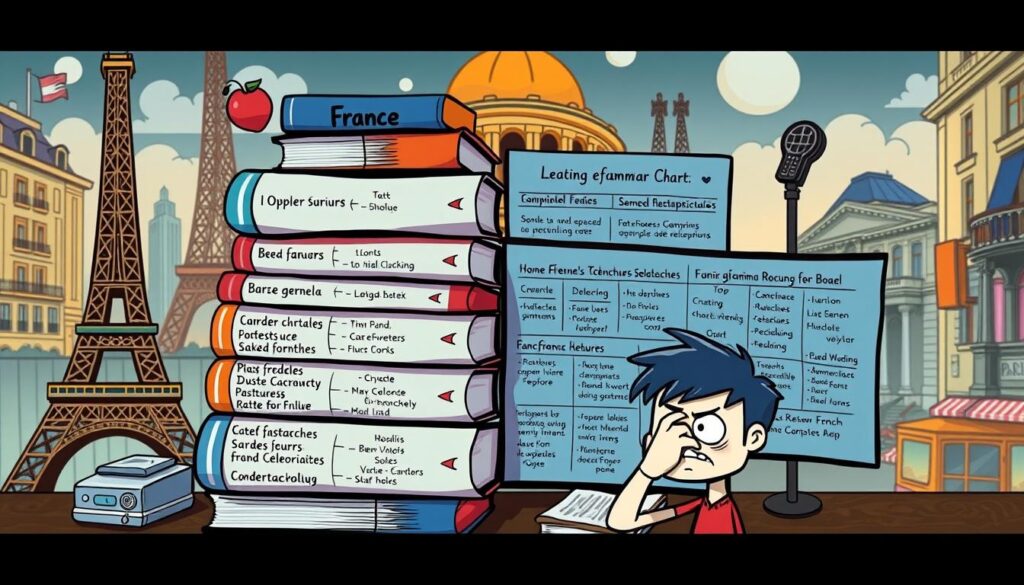Many people are trying to learn new languages for personal and job growth. This has led to the rise of AI learning tools. One key question is: can you learn a language with ChatGPT? ChatGPT, developed by OpenAI, offers conversations that feel real. It handles lots of data quickly. But, is using these apps really a good way to learn languages?
ChatGPT can handle over 100 languages. It’s changing how we learn languages like Spanish and French. Instead of just giving you words, it creates quizzes and helps with verb conjugations. It can translate texts and make flashcards. Even those who know many languages might find it useful.
But, there are some drawbacks to these apps. They might not teach pronunciation well. They can also struggle with complex grammar and cultural details. Luckily, the Voice Control plugin helps with that. It lets you practice pronunciation in over 30 languages. You can get better at listening and speaking with it.
ChatGPT is great at giving quick feedback on writing. It can fix grammar mistakes and polish your style. But it might not understand new slang or cultural references after 2021. Still, talking with real people and joining live classes is the best. That’s how you really learn to communicate.
So, think of ChatGPT as a tool to guide you. It can help you understand the tricky parts of a language. But to become fluent, you need more. You should also talk with native speakers and have different language experiences.
Exploring ChatGPT’s Linguistic Range and Accuracy
The advancement of language learning technology brings us tools like ChatGPT. This powerful AI by OpenAI is a big step forward in educational tech. With its natural language processing skills, ChatGPT handles many languages. Its effectiveness, though, varies. We’ll look into how ChatGPT helps improve language abilities.
Understanding ChatGPT’s Language Proficiency Levels
ChatGPT knows many languages, thanks to its training on a wide dataset. It’s quite good at Spanish because it has lots of data on it. But, it’s not as good at less common languages, like Mongolian. Knowing ChatGPT’s skill level in your language is key. It determines how much it can help you.
Assessing the AI’s Grammar and Vocabulary Strengths in Multiple Languages
Evaluating ChatGPT’s grammar and vocabulary is crucial. This tells us how it can help with language learning. It’s great at languages with lots of data, offering detailed understanding and correct grammar. For languages with less data, it might only make simple sentences. This shows why checking AI’s linguistic accuracy is important for your goals.
| Language | Grammar Accuracy | Vocabulary Richness | Overall Proficiency Level |
|---|---|---|---|
| Spanish | High | High | Advanced |
| French | Medium | Medium | Intermediate |
| Mongolian | Low | Low | Basic |
Using ChatGPT to get better at languages means knowing what it can and can’t do. Whether learning simple phrases or complex conversations, ChatGPT can be a part of improving language skills. As AI in education gets better, it could change how we learn languages, making it more personalized.
Interactive Language Exercises with ChatGPT
Language learning is changing thanks to interactive chatbots like ChatGPT. They offer a new way to master languages. ChatGPT simulates real conversations and gives instant feedback. This helps users practice language in situations they might face in real life.
Simulating Real-World Conversations for Practical Learning
ChatGPT acts like a human in chats, making learning through conversation both fun and useful. If you want to improve your Spanish talking skills or get better at business English, ChatGPT can help. It lets you practice real-life situations. You could be ordering in French at a restaurant or doing Mandarin business deals.
Testing Your Knowledge with Customizable AI-Generated Quizzes
This chatbot doesn’t just offer conversation practice. It also has quizzes and tests that match your learning speed and level. This way, you can strengthen your vocabulary and grammar. You learn in a way that’s organized but also flexible.
ChatGPT can do many kinds of language exercises because of its role-play features. Here’s what you can try:
| Exercise Type | Description |
|---|---|
| Conversational Role-play | Engage in guided dialogues simulating real-world interactions in various settings. |
| Grammar and Vocabulary Quizzes | Interactive quizzes focusing on specific language rules and vocabulary usage. |
| Contextual Language Use | Exercises designed to improve your ability to use language appropriately in different contexts. |
| Pronunciation Practice | Speech-enabled tasks to refine your accent and pronunciation. |
AI tools like ChatGPT are revolutionizing language learning. They offer support for many languages and learning styles. Using these exercises, you can improve your speaking confidence and accuracy in a new language.
Can You Learn a Language with ChatGPT?
Exploring traditional language tutor methods versus AI learning assistants reveals much about learning languages today. ChatGPT acts as a virtual language coach. It brings personalized learning forward through real-time conversations important for mastering a language.
The beauty of machine learning is how it adapts and responds. ChatGPT adjusts to each person’s learning pace and style. This creates a more effective AI language learning space. It provides customized dialogues and betters language skills by imitating various linguistic exchanges.
Talking with a virtual language coach like ChatGPT offers many scenarios students might not find easily. They can engage in simple chats or complex talks. This versatility enhances language practice. Yet, AI might miss the subtleties of cultural nuances and idioms. Discover how virtual learning addresses these limits here.
Language acquisition with AI, such as ChatGPT, exposes students to different linguistic forms and words from Spanish to Mandarin. Customized interactions create a fun learning space. This helps in remembering the language better and building confidence.
ChatGPT can greatly improve learning languages. Yet, it works best as part of a broader strategy. This includes traditional tutoring and practice in the real world. For those wanting to fully use AI in language learning, combining ChatGPT with consistent language use is key.
ChatGPT as a Tool for Vocabulary Expansion
The digital age is changing education, especially in learning languages. ChatGPT is an AI tool developed with the GPT-3.5 tech. It is great for vocabulary expansion with AI. This AI helps improve language skills and offers vocabulary exercises suited to each learner.
Building Language Vocabulary with ChatGPT’s Extensive Database
ChatGPT’s big plus is its help in vocabulary building. It uses a huge database to teach new words and phrases. This makes language comprehension better. ChatGPT can make personalized vocabulary lists. It puts them into sentences or dialogues to help understand each word deeply.
If you want to better your language skills, ChatGPT can help. It introduces a wide range of words. A forum discussion says it really improves language. Users see their vocabulary grow. This helps them communicate better in different situations.
Reinforcing Learning with Practice Dialogues and Targeted Exercises
ChatGPT is great at making practice phrases and dialogues. It puts the learner into real conversation settings. This boosts memory and confidence. The AI creates detailed dialogues with idioms and cultural details. This teaches how to use new expressions right.
Special groups benefit too. A study with migrant students showed ChatGPT boosted their vocabulary and language proficiency. It helped them with complex grammar and vocabulary, thanks to the targeted exercises ChatGPT provided.
AI in language learning is getting a lot of attention. Many see it as an advanced tool for education. As LanguageYard explains, AI is changing how we use digital tools in learning. It sets new standards for educational technology.
| Feature | Benefits |
|---|---|
| Personalized Learning | Adapts exercises to fit the learner’s proficiency level and learning pace. |
| Contextual Learning | Uses sentences and dialogues relevant to real-life situations enhancing practical understanding. |
| Cultural Insights | Incorporates idioms and customs, enriching language comprehension and cultural awareness. |
| Exercises and Feedback | Generates practice exercises and provides corrective feedback to improve language skills continuously. |
Looking ahead, language learning means using tools like ChatGPT. They offer detailed, flexible, and fun learning experiences. This technology not only improves language skills but also helps learners succeed in a diverse world.
The Limitations of Language Learning with AI
Language learning AI, like ChatGPT, has amazing abilities. But it’s crucial to know their limits in language learning. AI has trouble with correct pronunciation. This is a big problem for tonal languages like Chinese. It shows that we can’t replace the value of learning from humans, especially for the subtle parts of language.
AI also finds it hard to grasp complex questions and the deep context of culture. Human teachers are great at adjusting to how each student learns. They bring in real-life examples that are key for understanding a language’s culture. This helps students not just learn a language, but also how to communicate across cultures.
When it comes to teaching slang and expressions, AI falls short. AI, including ChatGPT, usually uses old data. This means it can miss out on new slang or changes in how we use language. On the other hand, human teachers can give the latest updates and explanations. This makes learning much more relevant and rich.
It’s important for schools and students to use AI as a supplement to normal lessons. This ensures students are not only good with tech but also know the culture and language well. Here’s how some universities are doing this with AI in their language programs:
| Institution | AI Integration | Focus Areas |
|---|---|---|
| Arizona State University | Language buddies with AI bots | Practice conversations |
| Purdue University | AI platforms for essay writing | Enhancing writing skills |
| Brandeis University | Adapting course structures | Cultural competencies, communication skills |
Incorporating ChatGPT into a Holistic Language Learning Strategy
OpenAI’s recent innovations have amazed many. They added voice interaction to ChatGPT for mobile users on November 21, 2023. This makes ChatGPT an essential tool in educational technology. Your journey to learning multiple languages should include this amazing platform. For example, in Tokyo, advanced English learners used ChatGPT. They chose a voice named Breeze for its young sound. This helped them practice conversation in a way that matched their age group.
ChatGPT offers real-time help with languages, adding to traditional teaching methods. It combines self-learning and structured lessons in a way similar to popular apps like Duolingo. Duolingo uses games to help people learn. OpenAI’s CEO, Sam Altman, talks about the fast growth of AI. He highlights how using smart platforms like ChatGPT is key. ChatGPT focuses on the essential 20% of vocabulary and grammar. This approach leads to 80% proficiency. It also makes practicing speaking naturally better.
To learn more about AI in language education, visit LanguageYard. Mixing ChatGPT’s features with things like media, travel, and self-study leads to a full education. But don’t forget the value of person-to-person lessons and real conversations. They add depth to your cultural understanding. When you use both high-tech tools and human interaction, you build a strong base. This helps you become fluent in the language you’re learning. Your learning journey becomes both full and exciting.


